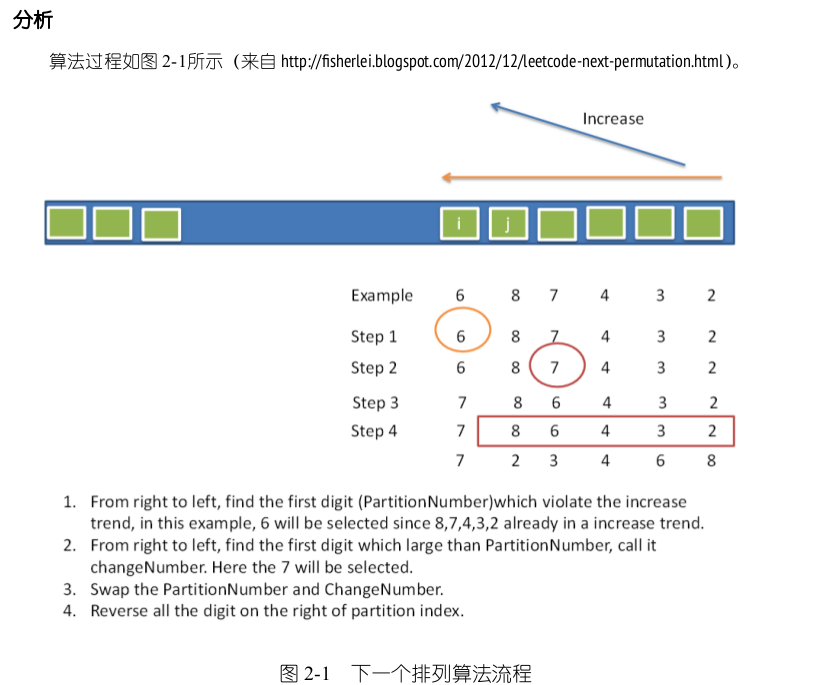Question
Implement next permutation, which rearranges numbers into the lexicographically next greater permutation of numbers.
If such arrangement is not possible, it must rearrange it as the lowest possible order (ie, sorted in ascending order).
The replacement must be in-place and use only constant extra memory.
Here are some examples. Inputs are in the left-hand column and its corresponding outputs are in the right-hand column.
1,2,3 → 1,3,23,2,1 → 1,2,31,1,5 → 1,5,1
Difficulty:Medium
Category:Array
Analyze
这一道题目,需要找到排列中的下一个顺序(从小到大),如果当前已经是最大的一个排列方式的话,那么下一个就跳转到最小的排列方式。两种情况:
- 如果这不是最大的一个排列,那么找到需要交换元素的两个值,交换元素之后,再进行反转,算法如下图所示:
- 如果这已经是最大的排列的话,那么直接反所有的元素就可以了。
下一个排列算法流程

图片来自有:《Leetcode 题解》 第19页
Solution
Solution 1
class Solution {
public:
void nextPermutation(vector<int>& nums) {
unsigned len = nums.size() - 1;
// Find an element from the right to left.
for (int i = len - 1; i >= 0; --i) {
if (nums[i + 1] > nums[i]) {
for (int j = len; j > i; --j) {
if (nums[j] > nums[i]) {
swap(nums[j], nums[i]);
reverse(nums.begin() + i + 1, nums.end());
return;
}
}
}
}
// If there are increate order from left to right.
reverse(nums.begin(), nums.end());
return;
}
};
Solution 2
稍微更加简洁的代码,来自有 [LeetCode] Next Permutation 下一个排列
class Solution {
public:
void nextPermutation(vector<int>& nums) {
int n = nums.size(), i = n - 2, j = n - 1;
while (i >= 0 && nums[i] >= nums[i + 1]) --i;
if (i >= 0) {
while (nums[j] <= nums[i]) --j;
swap(nums[i], nums[j]);
}
reverse(nums.begin() + i + 1, nums.end());
}
};
Solution 3
使用函数模板的方式解决, 具有普遍通用性,来自有:《Leetcode 题解》 第20页
class Solution {
public:
void nextPermutation(vector<int> &nums) { next_permutation(nums.begin(), nums.end()); }
template <typename BidiIt>
bool next_permutation(BidiIt first, BidiIt last) {
// Get a reversed range to simplify reversed traversal.
const auto rfirst = reverse_iterator<BidiIt>(last);
const auto rlast = reverse_iterator<BidiIt>(first);
// Begin from the second last element to the first element.
auto pivot = next(rfirst);
// Find `pivot`, which is the first element that is no less than its
// successor. `Prev` is used since `pivort` is a `reversed_iterator`.
while (pivot != rlast && *pivot >= *prev(pivot)) ++pivot;
// No such elemenet found, current sequence is already the largest
// permutation, then rearrange to the first permutation and return false.
if (pivot == rlast) {
reverse(rfirst, rlast);
return false;
}
// Scan from right to left, find the first element that is greater than
// `pivot`.
auto change = find_if(rfirst, pivot, bind1st(less<int>(), *pivot));
swap(*change, *pivot);
reverse(rfirst, pivot);
return true;
}
};
std::bind1st function The function object returned by bind1st has its operator() defined such that it takes only one argument. This argument is used to call binary function object op with x as the fixed value for the first argument.
template <class Operation, class T>
binder1st<Operation> bind1st(const Operation& op, const T& x) {
return binder1st<Operation>(op, typename Operation::first_argument_type(x));
}
Example:
// bind1st example
#include <algorithm>
#include <functional>
#include <iostream>
using namespace std;
int main() {
int numbers[] = {10, 20, 30, 40, 50, 10};
int cx;
cx = count_if(numbers, numbers + 6, bind1st(equal_to<int>(), 10));
cout << "There are " << cx << " elements that are equal to 10.\n";
return 0;
}